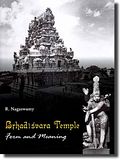Brhadisvara Temple
Nagaswamy, R.:
Bṛhadīśvara temple : form and meaning / R. Nagaswamy. - New Delhi : Indira Gandhi National Centre for the Arts ; Aryan Books International, 2010. - XV, 279 S. : Ill., Kt.
ISBN 978-81-7305-388-7
Rs. 2700,00
US$ 61,36 (Eastern Book Corp.)
EUR 87,66 (Exotic India)
US$ 103,55 (D.K. Agencies)
US$ 150,00 (K.K. Agencies)
DDC: 726.145513095482
Beschreibung
The Great Temple at Tanjavur is a visual representation of Cosmic power on earth that remains, according to the pious wish of the builder, so long as the sun and moon lasts. The God who inhabits this abode is said to be seated with his consort on the summit of the metaphysical mountain surrounded by a circle of peaks in which the divine power descends in diminishing potency as it comes down gradually and takes his abode at the peak of the circle, appropriate to his direction and also the relative importance in the hierarchy. So each peak is a virtual temple. This metaphysical mountain is called the great meru - Mahameru, which forms the basic concept of the Brhadisvara temple of Tanjore.
Meru, the mythical mountain is said to be a golden mountain. True to its nature, Rajaraja covered the superstructure of this temple with gold, that made this loftiest golden temple at the time. The images one sees on the upper tiers represented with bow and arrow in their arms are the innumerable Rudras called Sata-rudras, who are said to move in the upper spheres and represent the sun’s rays, a representation unique to this temple. This temple also portrays the five forms of Panca Brahmans - Tatpurusa, Aghora, Sadyojata, Vamadeva and Isana, in individual sculptural forms and enshrined in the lower niches. With four sides of the sanctum provided with openings and its height exactly double its width at the base, the lofty tower fulfils all requirements of the Meru type of temple architecture.
The Brhadisvara temple locates for the first time in Indian history, the 108 forms of nrtta karanas on the upper storey around the sanctum wall in sculptural form and reflects the concept of cosmic space in which Siva’s dance takes place. The available karanas are discussed in this volume for the first time in the light of Abhinavagupta’s commentary and also the views of modern scholars.
Every structure in the temple is dated with the help of inscriptions. The story is taken through the centuries and its change in meaning and ritual are brought out in this volume which points out what a Hindu temple mean when in full form and through the centuries. The personality of the builder, the role of Rajaguru in planning and guidance and also the names of architects who designed and carved the sculptures and executed the lovely paintings are also furnished in this volume which makes it an invaluable work on the temple. [Vom Buchumschlag]
Inhalt
Preface. v
List of Illustrations. ix
1. Introduction. 1
2. The Gateway to Brhadisvara. 4
3. The Brhadisvara Linga. 9
4. The Vimana - Main Tower. 45
5. The Mahamandapa. 91
6. Prakara. 99
7. The Candikesvara Temple. 110
8. Amman Shrine. 114
9. The Subrahmanya Temple. 121
10. Nandi and Nataraja Mandapas. 128
11. The Gopuras. 131
12. Torana Entrance. 140
13. The Brhadisvara Legends. 142
14. Natya Karanas: Dance and Dance Sculptures. 153
15. Rajaraja, the Patron. 230
16. Rajaguru - Isana Siva. 238
17. The Architect Rajaraja-Perumtaccan. 260
Bibliography. 267
Index. 271
Autor
R. NAGASWAMY (*1930) joined the Government Museum, Madras as the Curator for Art and Archaeology in 1959 and became the first Director of Archaeology of Tamil Nadu in 1966, in which capacity he served for 23 years, till his retirement in 1988. He has many publications and hundreds of research articles to his credit in English, Sanskrit and Tamil. His well-known publications include Masterpieces of South Indian Bronzes, Siva Bhakti, Tamil Coins, Tantric Cult in Tamil Nadu, Ancient Tamil Law and Society, Facets of South Indian Art and Architecture, Facets of South Indian Art and Architecture, Timeless Delight and others.
Quellen: Aryan Books International; D.K. Agencies; Exotic India; K.K. Agencies; Eastern Book Corp.
Ähnlich
- Kieven: Following the Cap-Figure in Majapahit Temple Reliefs
- Müller: Hinduistische Sakralbaukunst
- Rediscovering the Hindu Temple
- History of Indian Temple Architecture, Sculpture and Paintings
- Kalamukha Temples of Karnataka
- The great temple at Thanjavur
- Temples of the Indus
- Spink: Ajanta 6
- Talim: Bagh Caves
- Temple Imagery from Early Mediaeval Peninsular India

